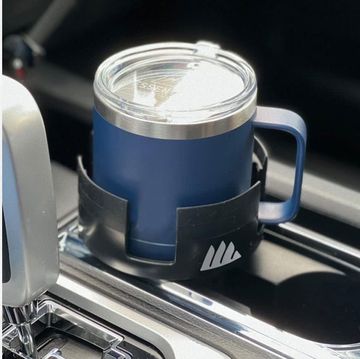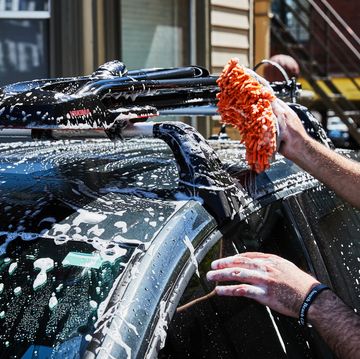Your wife has started to sound like a detergent commercial, bragging about the spilled coffee stains she's gotten out of your shirts. The kids are making excuses about why they'd rather ride their bikes to the mall than get a lift in your car, and even the dog has started to get carsick. Wake up, Bunky, and realize that your vehicle's ride has gone, literally and figuratively, downhill. Hey, there are over 60,000 miles on the odometer, and the tires are starting to develop little concave "cups," sure signs it's time for new shocks.
Of course, you could get the jouncy ride of worn shocks at much lower mileage, perhaps because you drive briskly on bad roads and accelerate the wearing-out process. Or maybe the shock mountings have loosened. Occasionally, a shock produces a visible leak of fluid, but some hint of weep is normal, and most shocks we've seen that were well worn out, also looked bone dry.
That's right, we're talking about shock absorbers. The MacPherson strut is in wide use, but conventional shocks are on lots of cars, plus almost all those SUVs, pickups and at least the rear suspension of minivans. Isn't replacing them just like changing struts, just easier because you don't have to compress and remove the coil spring? No, although some things are similar (a strut is really a type of shock absorber), the mountings--and therefore the replacement procedure--are different.
Removing shocks is usually straightforward, but getting under the vehicle and applying sufficient torque to remove large-diameter rusted-on fasteners can be daunting.
Those Mountings
Both shock mountings on most late-model vehicles are in the underbody, so if you support the chassis on safety stands, you have access to the top and bottom. One problem is reaching them. Another is getting off the hardware.
The first thing to do is see if the mountings are loose. If you can turn the mounting nut or bolt at the top or bottom without much effort, the mounting is loose. On some shocks there's a stud in a rubber bushing, and if it tears loose, you'll see and feel it turn as you try to tighten the nut. There's typically a hex on the stud, so you can hold the stud while you tighten the nut.When a nut and bolt loosen, you may be able to just retighten. However, it will loosen again if you don't apply some thread-locking compound to the threads. If the shock bushings' rubber is obviously cracked or badly distorted, you'll usually have to replace the shocks to get the new bushings. That's okay, because the shocks themselves don't figure to be in much better shape.
Generally, a socket will spin off the mounting hardware. New hardware is usually included with the shock.
Replacement Shocks
The aftermarket manufacturers produce replacement shocks for just about everything, except some electronically controlled designs. Only a handful of electronic systems' shocks are not available from third parties, either because they're an oddball size or because the tie-in to the vehicle electronics would result in a ride/ handling glitch if you installed nonelectronic replacements. It might be as little as a trouble code or warning light, but if there's major integration (as on the late-model Cadillacs), it could be more than that.
Just check the manufacturer's catalog, and if there are shock absorbers listed for your exact year, make and model, and the listing says it covers the electronic control system type, you're cool. You will be giving up the electronic control, but there isn't a system that's all that sophisticated on anything but a few premium cars, such as Cadillac, Corvette and some other high-end sports cars.
If the aftermarket catalog doesn't list a replacement, you're stuck with ordering replacement shocks from a dealer. On some Ford products there's an external motor drive, and you can unplug it from the old shock and install it on the new one. In most other cases, you get a choice of shock absorber designs.
If the shock rod spins endlessly as you try to remove the upper mount, try Vise-Grips on the flatted end of the rod.
Getting The Shock Off
If there's an electrical connector, start by unplugging it. No electronics problem with installing conventional shocks? You could just cut the wiring, and tape securely. But if there's any chance you or a subsequent owner will want to re-establish the system, that won't work.
If the connector is in the trunk, that's easy (just tape over it). But if it's underneath, find a safe location away from exhaust heat, pack it with pieces of plastic foam stuffed against the terminals, put it into a heavy plastic pouch, seal and hold it in place with a cable tie.
Loosening a rust-frozen nut and bolt is one of the major headaches in shock replacement. If a nut is exposed, you should be able to loosen it with a nut splitter, a clamplike tool you often can rent from an auto parts store. No space for the splitter? Penetrating solvent, followed by heat from a torch, is another possibility. The most difficult is the type where the piston rod turns when you try to loosen the nut. One approach is to clamp locking pliers onto the "double-D" end of the piston rod, hold it from turning with the pliers and loosen the nut with a conventional wrench. Something better (particularly for recessed installations) is a special toolkit with a hollow hex that fits over the rod onto the nut, followed by a wrench (made to fit the double-D) that goes through the hollow hex onto the double-D end. The kit, about $11, is Lisle No. 20400, and it's available in auto parts stores. It comes with three hollow hexes for most U.S. makes. There's also one specifically for some Ford products (No. 20390). If the shock piston end (or stud end) has a conventional hex, you can use an ordinary socket, of course.
Many shocks are mounted on studs, and we've even seen those where the shock upper mount has a retaining bracket held by an additional stud and bolt. It's not a major difficulty, just extra hardware to remove. When you get the nuts off a stud mounting, you still have to pry off the shock, working evenly at top and bottom so it doesn't cock. If you're not sure of the condition of a bone-dry shock, just disconnect it from the bottom mount if possible (or remove it completely if it's on studs). Then slowly compress the shock (even low-pressure gas shocks will be easily compressed). If you feel any lost motion ("looseness" or unevenness), the shock is worn out.
Installing New Shocks
If you're on a budget and installing nongas shocks, it's a good idea to make sure they don't have air inside and bleed it out if they do. (Don't try this on old shocks. If they have air inside, it's from internal wear, and bleeding is not a cure.) With new nongas shocks, bleed by holding each shock upright (installed position): Extend it, and then turn it upside down and compress. Repeat the procedure a few times and the new shock should operate smoothly, with somewhat greater resistance on extension.
Using adjustable shocks? Some have soft, normal and firm positions, and although you can make adjustments after installation, start with soft or normal (firm is best for "ride restoration" after tens of thousands of miles of use).
The mounts for replacement shocks often are very different from those for the originals. That's okay, so long as you follow the instructions carefully. A common example is the aftermarket hardware for the "stud-in-bushing" design used on many General Motors cars. There's a specially shaped steel replacement stud assembly that goes into the lower mounting, and the bushing that's in the replacement shock just slides onto it.
If the shock mounts on studs and the nut is tough to thread on, clean the threads with a wire brush and apply penetrating oil/solvent. If the nut almost spun off, apply a film of thread-locking compound to the stud. If you can tighten the shock hardware to specs without distorting the bushing, that's ideal. If the nut hits the end of the threads and the bushings are loose, you've got the wrong ones--or you're missing some hardware.
Lower mounting bolts are usually, but not always, included in the new shock's box.
HOW IT WORKS: Shock Absorbers Don't Absorb Shocks
A shock absorber doesn't absorb shock (the spring does that, by flexing to absorb the energy of an impact). The shock absorber actually stops the vehicle from bouncing up and down on the flexing spring. It does this by transferring the spring-flexing energy to a piston in an oil-filled chamber, which dissipates it in the form of heat. Most shocks have twin-tube (chamber) arrangements, an inner chamber with the piston and a calibrated valve at the bottom, which has the entry passage to an outer chamber--the reservoir. When the piston comes down on compression, it forces fluid through the calibrated valve into the reservoir. When the piston moves up as the shock absorber extends, oil is drawn from the reservoir into the main chamber, and some also flows through orifices in the piston, as part of the ride control calibration. A charge of low-pressure gas in the reservoir reduces oil foaming, which would affect ride control. Many high-performance shocks, including some for heavy loads such as motorhomes, are of single-tube construction, with a high-pressure gas charge in the base. Fluid flow is between the areas below and above the piston, which has a sophisticated valve assembly. The higher pressure of the single-tube design is even more effective against fluid aeration, but at the expense of ride comfort. Strut replacement is sometimes a job for a pro with the right tools and coil spring compressors.














